Related Research Articles

A comet is an icy, small Solar System body that warms and begins to release gases when passing close to the Sun, a process called outgassing. This produces an extended, gravitationally unbound atmosphere or coma surrounding the nucleus, and sometimes a tail of gas and dust gas blown out from the coma. These phenomena are due to the effects of solar radiation and the outstreaming solar wind plasma acting upon the nucleus of the comet. Comet nuclei range from a few hundred meters to tens of kilometers across and are composed of loose collections of ice, dust, and small rocky particles. The coma may be up to 15 times Earth's diameter, while the tail may stretch beyond one astronomical unit. If sufficiently close and bright, a comet may be seen from Earth without the aid of a telescope and can subtend an arc of up to 30° across the sky. Comets have been observed and recorded since ancient times by many cultures and religions.

Sir Fred Hoyle (24 June 1915 – 20 August 2001) was an English astronomer who formulated the theory of stellar nucleosynthesis and was one of the authors of the influential B2FH paper. He also held controversial stances on other scientific matters—in particular his rejection of the "Big Bang" theory (a term coined by him on BBC Radio) in favor of the "steady-state model", and his promotion of panspermia as the origin of life on Earth. He spent most of his working life at the Institute of Astronomy at Cambridge and served as its director for six years.
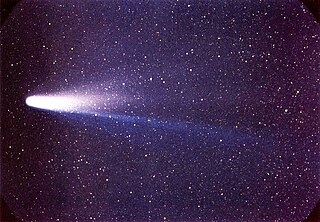
Halley's Comet, Comet Halley, or sometimes simply Halley, officially designated 1P/Halley, is a short-period comet visible from Earth every 75–79 years. Halley is the only known short-period comet that is regularly visible to the naked eye from Earth, and thus the only naked-eye comet that can appear twice in a human lifetime. It last appeared in the inner parts of the Solar System in 1986 and will next appear in mid-2061.
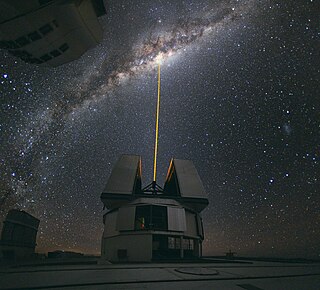
Astronomy is a natural science that studies celestial objects and phenomena. It uses mathematics, physics, and chemistry in order to explain their origin and evolution. Objects of interest include planets, moons, stars, nebulae, galaxies, meteoroids, asteroids, and comets. Relevant phenomena include supernova explosions, gamma ray bursts, quasars, blazars, pulsars, and cosmic microwave background radiation. More generally, astronomy studies everything that originates beyond Earth's atmosphere. Cosmology is a branch of astronomy that studies the universe as a whole.

Frank Donald Drake was an American astrophysicist and astrobiologist.

Thomas C. Van Flandern was an American astronomer and author specializing in celestial mechanics. Van Flandern had a career as a professional scientist, but was noted as an outspoken proponent of certain fringe views in astronomy, physics, and extra-terrestrial life. He also published the non-mainstream Meta Research Bulletin.

Astrophysics is a science that employs the methods and principles of physics and chemistry in the study of astronomical objects and phenomena. As one of the founders of the discipline, James Keeler, said, Astrophysics "seeks to ascertain the nature of the heavenly bodies, rather than their positions or motions in space–what they are, rather than where they are." Among the subjects studied are the Sun, other stars, galaxies, extrasolar planets, the interstellar medium and the cosmic microwave background. Emissions from these objects are examined across all parts of the electromagnetic spectrum, and the properties examined include luminosity, density, temperature, and chemical composition. Because astrophysics is a very broad subject, astrophysicists apply concepts and methods from many disciplines of physics, including classical mechanics, electromagnetism, statistical mechanics, thermodynamics, quantum mechanics, relativity, nuclear and particle physics, and atomic and molecular physics.

Jan Hendrik Oort was a Dutch astronomer who made significant contributions to the understanding of the Milky Way and who was a pioneer in the field of radio astronomy. The New York Times called him "one of the century's foremost explorers of the universe"; the European Space Agency website describes him as "one of the greatest astronomers of the 20th century" and states that he "revolutionised astronomy through his ground-breaking discoveries." In 1955, Oort's name appeared in Life magazine's list of the 100 most famous living people. He has been described as "putting the Netherlands in the forefront of postwar astronomy."

Vera Florence Cooper Rubin was an American astronomer who pioneered work on galaxy rotation rates. She uncovered the discrepancy between the predicted and observed angular motion of galaxies by studying galactic rotation curves. By identifying the galaxy rotation problem, her work provided evidence for the existence of dark matter. These results were later confirmed over subsequent decades.

Fred Lawrence Whipple was an American astronomer, who worked at the Harvard College Observatory for more than 70 years. Amongst his achievements were asteroid and comet discoveries, the "dirty snowball" hypothesis of comets, and the invention of the Whipple shield.
Damocloids are a class of minor planets such as 5335 Damocles and 1996 PW that have Halley-type or long-period highly eccentric orbits typical of periodic comets such as Halley's Comet, but without showing a cometary coma or tail. David Jewitt defines a damocloid as an object with a Jupiter Tisserand invariant (TJ) of 2 or less, while Akimasa Nakamura defines this group with the following orbital elements:
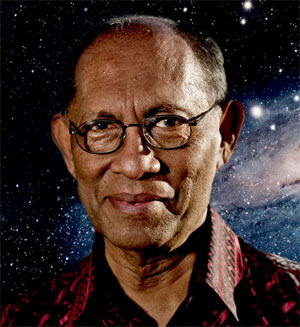
Nalin Chandra Wickramasinghe is a Sri Lankan-born British mathematician, astronomer and astrobiologist of Sinhalese ethnicity. His research interests include the interstellar medium, infrared astronomy, light scattering theory, applications of solid-state physics to astronomy, the early Solar System, comets, astrochemistry, the origin of life and astrobiology. A student and collaborator of Fred Hoyle, the pair worked jointly for over 40 years as influential proponents of panspermia. In 1974 they proposed the hypothesis that some dust in interstellar space was largely organic, later proven to be correct.

The nucleus is the solid, central part of a comet, formerly termed a dirty snowball or an icy dirtball. A cometary nucleus is composed of rock, dust, and frozen gases. When heated by the Sun, the gases sublime and produce an atmosphere surrounding the nucleus known as the coma. The force exerted on the coma by the Sun's radiation pressure and solar wind cause an enormous tail to form, which points away from the Sun. A typical comet nucleus has an albedo of 0.04. This is blacker than coal, and may be caused by a covering of dust.

Discovery and exploration of the Solar System is observation, visitation, and increase in knowledge and understanding of Earth's "cosmic neighborhood". This includes the Sun, Earth and the Moon, the major planets Mercury, Venus, Mars, Jupiter, Saturn, Uranus, and Neptune, their satellites, as well as smaller bodies including comets, asteroids, and dust.
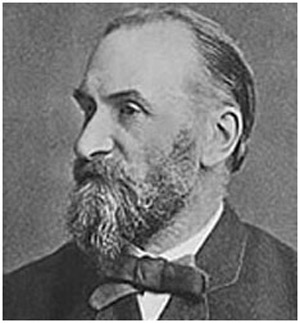
William Grylls Adams was professor of Natural Philosophy at King's College, London. He was active in research on subjects ranging from light, magnetism, and astronomy to electrical power generation and transmission. His research in optics yielded the discovery that certain materials, notably selenium, produce an electric current when exposed to light. Adams also actively participated in many academic societies and held major positions within the societies.

Vahagn "Vahe" Gurzadyan is an Armenian mathematical physicist and a professor and head of Cosmology Center at Yerevan Physics Institute, Yerevan, Armenia, best known for co-writing "Concentric circles in WMAP data may provide evidence of violent pre-Big-Bang activity" paper with his colleague, Roger Penrose, and collaborating on Roger Penrose's recent book Cycles of Time.
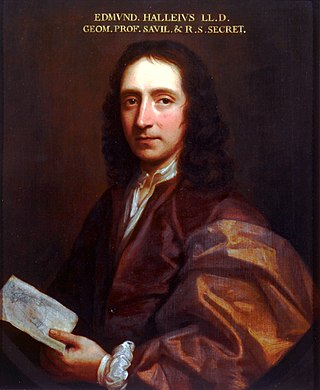
EdmondHalley was an English astronomer, mathematician and physicist. He was the second Astronomer Royal in Britain, succeeding John Flamsteed in 1720.

Werner Landgraf is a German astrophysicist and a discoverer of minor planets.

Historical models of the Solar System began during prehistoric periods and are updated to this day. The models of the Solar System throughout history were first represented in the early form of cave markings and drawings, calendars and astronomical symbols. Then books and written records became the main source of information that expressed the way the people of the time thought of the Solar System.

Ferdinand Ellerman was an American astronomer and photographer. He spent a good part of his career as an associate of the solar astronomer George E. Hale, and is known for his study of a phenomenon in the solar chromosphere later dubbed Ellerman bombs.
References
- ↑ "Oxford Physics Public Lectures". Oxford University.
- ↑ "Halley Lecture: Dynamics and history of the Milky Way". 27 October 2022.
- 1 2 "Is Dark Matter Made of Black Holes".
- ↑ "Adam Showman". 10 June 2016.
- ↑ "Remembering Adam Showman". 23 March 2020.
- ↑ "Theoretical physics". University of Oxford Department of Physics.
- ↑ "Observation of the mergers of binary black holes: The opening of gravitational wave astronomy".
- ↑ "Halley Lecture". ox.ac.uk. Retrieved 14 July 2023.
- ↑ "Halley Lecture. 'Understanding the Monsoon'" (PDF). ox.ac.uk. Retrieved 14 July 2023.
- ↑ "Halley Lecture - 'Building stars, planets and the ingredients for life between the stars' Prof Dr E.F. Van Dishoeck | University of Oxford Department of Physics".
- ↑ "Public Outreach". University of Oxford Department of Physics.
- ↑ "Lectures and Seminars Trinity Term 2012 (1) - University of Oxford".
- ↑ Longair, M. S. (October 1985). "The Universe - present, past and future". The Observatory. 105: 171–188. Bibcode:1985Obs...105..171L.
- ↑ Chandrasekhar, S. (October 1972). "The increasing role of general relativity in astronomy". The Observatory. 92: 160. Bibcode:1972Obs....92..160C.
- ↑ Townes, Charles H.. "Interstellar molecules. (A written version of the Halley lectures 1976, delivered in Oxford, 4 June 1976)." Physics-Uspekhi (1979): n. pag. (Usp. Fiz. Nauk; (USSR); Journal Volume: 127:3) https://www.osti.gov/etdeweb/biblio/5636519
- ↑ Bondi, H. (August 1962). "Physics and cosmology". The Observatory. 82: 133–143. Bibcode:1962Obs....82..133B.
- ↑ Ryle, M. (August 1955). "Radio stars and their cosmological significance". The Observatory. 75: 137–147. Bibcode:1955Obs....75..137R.
- ↑ Oort, J. H. (August 1951). "Origin and development of comets". The Observatory. 71: 129–144. Bibcode:1951Obs....71..129O. Reprinted as: Oort, Jan Hendrik (1951). Origin and development of comets, the Halley lecture for 1951, delivered at Oxford on May 1. OCLC 10898462.
- ↑ Bullard, E. C. (August 1950). "The origin of the Earth's magnetic field". The Observatory. 70: 139–143. Bibcode:1950Obs....70..139B.
- ↑ "Morphological Astronomy". Nature. 162 (4120): 627–628. October 1948. Bibcode:1948Natur.162..627.. doi: 10.1038/162627a0 . S2CID 4103200.
- ↑ "Fritz Zwicky: Halley lecture".
- ↑ William Marshall Smart, Sea and Air Navigation: Being the Halley Lecture Delivered on 3 June 1941 Oxford University Press, H. Milford, 1941.
- ↑ "The origin of meteorites; being the Halley lecture delivered on 16 May 1940". WorldCat. OCLC 5431515.
- ↑ "The earth as a clock, being the Halley lecture delivered on 5 June 1939". WorldCat. Retrieved 14 July 2023.
- ↑ "The minor planets of the Hecuba group, being the Halley lecture delivered on 16 June 1938". WorldCat. Retrieved 14 July 2023.
- ↑ "The dimensions and structure of the galaxy; being the Halley lecture delivered on 5 June 1935". WorldCat. Retrieved 14 July 2023.
- ↑ Hubble, Edwin Powell. "Red-shifts in the Spectra of Nebulae." Oxford (1934) WorldCat
- ↑ The composition of the stars. 1933.
- ↑ J., H. S. (February 1937). "Five Halley Lectures". Nature. 139 (3511): 266–267. Bibcode:1937Natur.139..266H. doi:10.1038/139266a0. S2CID 4079876.
- ↑ "The rotation of the galaxy, being the Halley lecture delivered on 30 May 1930". www.worldcat.org. WorldCat.org. Retrieved 14 July 2023.
- ↑ "Some problems of Indian meteorology; being the Halley lecture delivered on 31 May 1929 | WorldCat.org". www.worldcat.org. Retrieved 14 July 2023.
- ↑ Modern eclipse problems, being the Halley lecture delivered on 20 May, 1927, with notes for the observation of the eclipse of 29 June, 1927 WorldCat
- ↑ "Radioactivity and the surface history of the earth; being the Halley lecture, delivered on 28 May, 1924". WorldCat. Retrieved 14 July 2023.
- ↑ "Scott's Polar Journey and the Weather". Nature. 117 (2953): 778. June 1926. doi: 10.1038/117778a0 . S2CID 4032924.
- ↑ "Scott's polar journey and the weather". WorldCat. Retrieved 14 July 2023.
- ↑ Jeffreys, Harold (May 1923). "The Nebular Hypothesis and Modern Cosmogony: being the Halley Lecture delivered on May 23, 1922". Nature. 111 (2794): 662–663. Bibcode:1923Natur.111..662J. doi:10.1038/111662a0. S2CID 32292299.
- ↑ "Historical eclipsis". WorldCat. Retrieved 14 July 2023.
- ↑ "On Gravitation and Relativity: being the Halley Lecture 1920". WorldCat. Retrieved 14 July 2023.
- ↑ "The earth's magnestism". WorldCat. Retrieved 14 July 2023.
- ↑ "Celestial ejectamenta the first Halley lecture delivered before the University on Tuesday, May 10, 1910". WorldCat. Retrieved 14 July 2023.